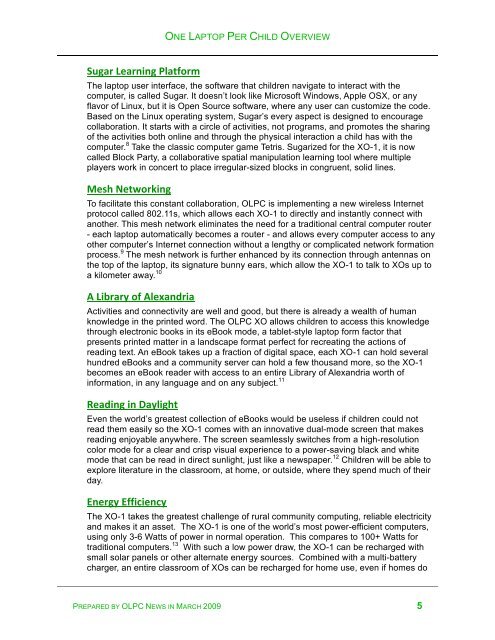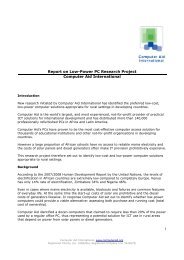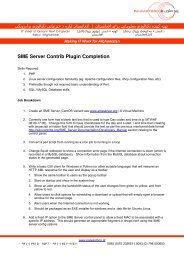ONE LAPTOP PER CHILD OVERVIEW - OLPC News
ONE LAPTOP PER CHILD OVERVIEW - OLPC News
ONE LAPTOP PER CHILD OVERVIEW - OLPC News
Create successful ePaper yourself
Turn your PDF publications into a flip-book with our unique Google optimized e-Paper software.
<strong>ONE</strong> <strong>LAPTOP</strong> <strong>PER</strong> <strong>CHILD</strong> <strong>OVERVIEW</strong><br />
SugarLearningPlatform<br />
The laptop user interface, the software that children navigate to interact with the<br />
computer, is called Sugar. It doesn’t look like Microsoft Windows, Apple OSX, or any<br />
flavor of Linux, but it is Open Source software, where any user can customize the code.<br />
Based on the Linux operating system, Sugar’s every aspect is designed to encourage<br />
collaboration. It starts with a circle of activities, not programs, and promotes the sharing<br />
of the activities both online and through the physical interaction a child has with the<br />
computer. 8 Take the classic computer game Tetris. Sugarized for the XO-1, it is now<br />
called Block Party, a collaborative spatial manipulation learning tool where multiple<br />
players work in concert to place irregular-sized blocks in congruent, solid lines.<br />
MeshNetworking<br />
To facilitate this constant collaboration, <strong>OLPC</strong> is implementing a new wireless Internet<br />
protocol called 802.11s, which allows each XO-1 to directly and instantly connect with<br />
another. This mesh network eliminates the need for a traditional central computer router<br />
- each laptop automatically becomes a router - and allows every computer access to any<br />
other computer’s Internet connection without a lengthy or complicated network formation<br />
process. 9 The mesh network is further enhanced by its connection through antennas on<br />
the top of the laptop, its signature bunny ears, which allow the XO-1 to talk to XOs up to<br />
a kilometer away. 10<br />
ALibraryofAlexandria<br />
Activities and connectivity are well and good, but there is already a wealth of human<br />
knowledge in the printed word. The <strong>OLPC</strong> XO allows children to access this knowledge<br />
through electronic books in its eBook mode, a tablet-style laptop form factor that<br />
presents printed matter in a landscape format perfect for recreating the actions of<br />
reading text. An eBook takes up a fraction of digital space, each XO-1 can hold several<br />
hundred eBooks and a community server can hold a few thousand more, so the XO-1<br />
becomes an eBook reader with access to an entire Library of Alexandria worth of<br />
information, in any language and on any subject. 11<br />
ReadinginDaylight<br />
Even the world’s greatest collection of eBooks would be useless if children could not<br />
read them easily so the XO-1 comes with an innovative dual-mode screen that makes<br />
reading enjoyable anywhere. The screen seamlessly switches from a high-resolution<br />
color mode for a clear and crisp visual experience to a power-saving black and white<br />
mode that can be read in direct sunlight, just like a newspaper. 12 Children will be able to<br />
explore literature in the classroom, at home, or outside, where they spend much of their<br />
day.<br />
EnergyEfficiency<br />
The XO-1 takes the greatest challenge of rural community computing, reliable electricity<br />
and makes it an asset. The XO-1 is one of the world’s most power-efficient computers,<br />
using only 3-6 Watts of power in normal operation. This compares to 100+ Watts for<br />
traditional computers. 13 With such a low power draw, the XO-1 can be recharged with<br />
small solar panels or other alternate energy sources. Combined with a multi-battery<br />
charger, an entire classroom of XOs can be recharged for home use, even if homes do<br />
PREPARED BY <strong>OLPC</strong> NEWS IN MARCH 2009 5




